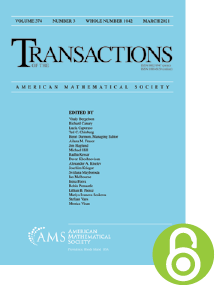Inverses of infinite sign regular matrices
HTML articles powered by AMS MathViewer
- by C. de Boor, S. Friedland and A. Pinkus PDF
- Trans. Amer. Math. Soc. 274 (1982), 59-68 Request permission
Abstract:
Let $A$ be an infinite sign regular (sr) matrix which can be viewed as a bounded linear operator from ${l_\infty }$ to itself. It is proved here that if the range of $A$ contains the sequence $( \ldots ,1, - 1,1, - 1, \ldots )$, then $A$ is onto. If ${A^{ - 1}}$ exists, then $D{A^{ - 1}}D$ is also sr, where $D$ is the diagonal matrix with diagonal entries alternately $1$ and $- 1$. In case $A$ is totally positive (tp), then $D{A^{ - 1}}D$ is also tp under additional assumptions on $A$.References
- Carl de Boor, The inverse of a totally positive bi-infinite band matrix, Trans. Amer. Math. Soc. 274 (1982), no. 1, 45–58. MR 670917, DOI 10.1090/S0002-9947-1982-0670917-5
- A. S. Cavaretta Jr., W. Dahmen, C. A. Micchelli, and P. W. Smith, On the solvability of certain systems of linear difference equations, SIAM J. Math. Anal. 12 (1981), no. 6, 833–841. MR 635236, DOI 10.1137/0512069
- Ronald A. DeVore and Karl Scherer (eds.), Quantitative approximation, Academic Press, Inc. [Harcourt Brace Jovanovich, Publishers], New York-London, 1980. MR 588164
- Samuel Karlin, Total positivity. Vol. I, Stanford University Press, Stanford, Calif., 1968. MR 0230102
- Charles A. Micchelli, Infinite spline interpolation, Approximation in Theorie und Praxis (Proc. Sympos., Siegen, 1979) Bibliographisches Inst., Mannheim, 1979, pp. 209–238. MR 567661
Additional Information
- © Copyright 1982 American Mathematical Society
- Journal: Trans. Amer. Math. Soc. 274 (1982), 59-68
- MSC: Primary 47B37; Secondary 15A09
- DOI: https://doi.org/10.1090/S0002-9947-1982-0670918-7
- MathSciNet review: 670918


